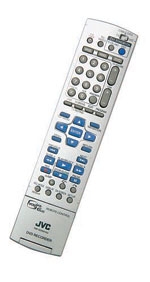DVD Diversity Page 4
JVC DR-MX1Have your hard disk and a VCR, too!
JVC's most expensive recorder takes us into another realm altogether - signaled by the classy fold-down faceplate. By far the most complicated DVD recorder I've tested, the DR-MX1 is actually three components in one: a DVD recorder, a VCR, and an 80-gigabyte hard-disk video recorder that can hold up to 147 hours in its lowest-quality mode. The 100-page manual treats each recorder section separately, which is probably the most logical way to approach such a versatile machine. 
|
Like the last JVC hard-disk/DVD recorder I reviewed, the DR-MV1 (see "Copy Cats" from the October 2004 issue), the hard-disk section of the DR-MX1 offers only some of the features that make TiVo and similar devices so popular. While the JVC provides simultaneous recording/playback functions, like being able to pause playback of whatever you're recording while the recording itself continues, it doesn't include an onscreen electronic program guide (EPG) to help you schedule your recordings - probably the most powerful feature that TiVo offers. The JVC allows only for manual or VCR Plus+ timer programming, which get the job done but are far less convenient or sexy than an EPG. Fortunately, being able to use the supplied infrared emitter to choose the channels on a satellite receiver or cable box makes up somewhat for this shortcoming.
The JVC's VHS section is likewise pretty basic. As with the hard disk, you're limited to manual programming or VCR Plus+. It plays S-VHS tapes at standard VHS resolution - which is an issue only if you have a lot of S-VHS recordings in your library. And like the Philips, it records only in standard-VHS mode.
The DVD section records on both DVD-RAM and DVD-R/RW discs, but you have to use DVD-RAM for simultaneous recording and playback. Those functions are similar to the ones you get on the hard-disk recorder, but the small differences in operation can be confusing.
 Having three video recorders in a single chassis is an invitation to synergy, and JVC takes full advantage of it. As long as the material isn't copy-protected, you can use simple menu-based commands to dub from any medium to any other, giving you a total of six paths among hard disk, DVD, and VHS. And a high-speed dubbing mode lets you make bit-accurate transfers between the hard drive and a DVD.
Having three video recorders in a single chassis is an invitation to synergy, and JVC takes full advantage of it. As long as the material isn't copy-protected, you can use simple menu-based commands to dub from any medium to any other, giving you a total of six paths among hard disk, DVD, and VHS. And a high-speed dubbing mode lets you make bit-accurate transfers between the hard drive and a DVD.
Once your recording is safely on the hard disk, you can use the JVC's playlist-editing powers to cut, paste, rearrange, or shorten the segments. Or you can edit your masterpiece on a computer and then use the i.Link input to transfer it to the recorder's hard disk with little or no loss of image or sound quality. From there it's easy to make DVD and VHS copies.
Such versatility - and I'm only scratching the surface - comes at a price: the DR-MX1 is complicated to use. Major functions are simple to operate, but difficulties can arise when the individual quirks of one medium or format clash with those of another, and here you're dealing with six possibilities. This makes for a long, dense manual full of exceptions and caveats in small print.
The JVC's i.Link input can automatically start playback of whatever source you have plugged into it when you begin the DVD recording. This worked fine with a couple of DV camcorders but not with the i.Link output of another DVD recorder, even though it was playing test patterns that weren't copy-protected. But I discovered that I could "force" the JVC to record the test patterns - as well as the i.Link output from a computer - by starting the source playback and holding down the record button on the front panel until recording started. PDF: Features Checklist PDF: In the Lab
The Bottom LineAs usual, which of these decks will appeal to you will have a lot to do with the kind of video recording you like to do. If, like my friend Rob, you want to rid yourself of VHS tape and already have a VCR, the Sony might be the best choice. It's only $400, takes full advantage of four disc formats, and can give you simultaneous record/playback - as long as you follow the rules.
If your VCR is on its last legs, but you still want to record and watch VHS tapes, you should consider the Philips or the JVC. The Philips is less expensive than the JVC and a lot easier to operate, especially its editing functions. But because it lacks play-list editing, you won't be able to get too creative with your camcorder footage.
If you want the whole kit-and-caboodle and are willing to pay extra for it, get the JVC. With its record on-anything/from-anything design, the DR-MX1 is so versatile you can use either the hard disk or DVD-RAM for TiVo-like simultaneous recording and playback. While DVD-RAM discs are harder to find than the other formats, the JVC's hard-disk recorder means you don't really need them. You can do all your work on the big hard drive and permanently save it on cheap and easy-to-find DVD-Rs. Rob is not going to have an easy choice.





























































